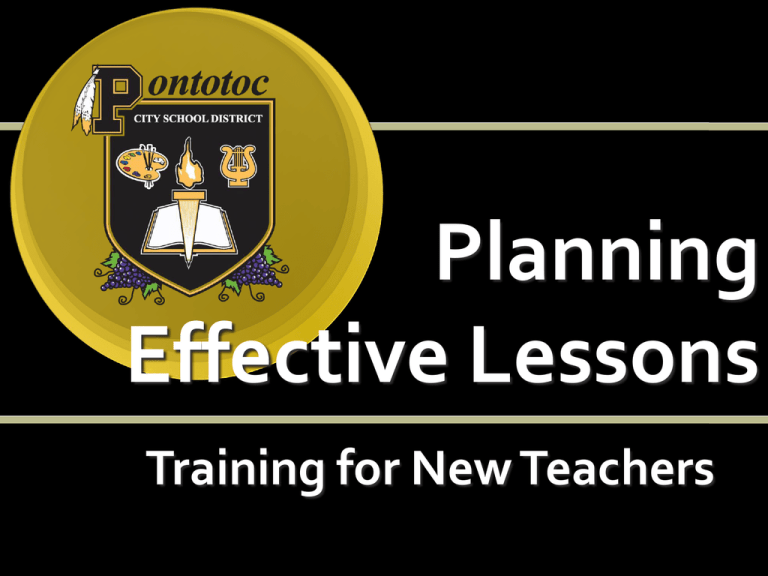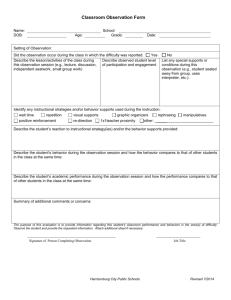Planning Effective Lessons Training for New Teachers
advertisement

Planning Effective Lessons Training for New Teachers Pontotoc City School District We believe LEARNING is a priority, a need, and a desire. To be successful, we must nurture a learning community that allows everyone to participate in trusting, respectful relationships. Together, we are committed to Reaching Higher Levels of Learning. Agenda Pretest - Alpha Boxes Introduction – Why Are We Here? Icebreaker – Just For Fun Decisions in Teaching ITIP Match Elements with Lesson Planner Closure – Alpha Boxes Big Ideas Instruction that is challenging, authentic, experiential and holistic is the most effective way to ensure high levels of learning. (Zemelman & Daniels & Hyde, 2005) A focus on the lesson itself – linked to high standards – provides our best chance to improve student learning and hence improve instruction. (Schmoker, 2006) Research has identified nine broad teaching strategies that have positive effects on student learning. (Marzano & Pickering & Pollock, 2001) Clearly, we want our designs to be engaging. For unless students are provoked, enticed, or intrigued by the work, why would they persist or give their best effort? But engaging work is insufficient. The work must also be effective. In other words, the work must promote and make possible maximum achievement. The bottom line is performance showing that the design makes students achieve the targeted understandings. (Wiggins & McTighe, 1999) Essential Questions How can decisions in teaching impact student achievement? What factors impact instruction? What constitutes an effective and engaging lesson? What constitutes an effective instructional strategy? What instructional strategies impact student achievement? How can planning and implementing effective lessons impact student achievement? Outcome The design or enhancement of unit lessons and daily lesson plans that are focused on standards, with skills and objectives aligned with effective instructional strategies, that ensures learning for all students. Who is Here? Just For Fun Decisions in Teaching The Teacher Decision-Making Model Emerged from examination of research and from informed observations of successful teaching Incorporates psychological principles, as well as current cognitive research into the functioning of the brain Provides an organization scheme for planning implementing, and analyzing decisions that affect both teaching and learning The Teacher The model is centered on the teacher, who, utilizing research, experience, and intuition, makes and implements decisions in three basic categories. It is important for the teacher to identify consciously and deliberately the decisions they must make in each category and base their decisions on research-validated knowledge. Equally important is the teacher’s ability to “read” signals from students and to assess the learning situation, so necessary adjustments can be made. There is nothing that a teacher must always do except think and teach in a way that maintains the dignity of every learner. Teaching Teaching can be defined as a constant stream of professional decisions made before, during, and after interaction with the student; decisions that when implemented, increase the probability of learning. The professional must learn, internalize, and implement with artistry the contributions of science plus one’s own intuition to increase productive functioning. The scientific principles must always be interpreted in light of the needs of the learner in her/his particular life space and modified to accommodate those needs. Teaching The synthesis of science and sensitivity to a situation explains why we can’t supply pat answers to teachers. We can, however, equip educators with research-validated principles on which to base their decisions while adapting them to the individuality of students and situations. All teaching decisions can be placed into three categories: Content – what is to be learned Learning Behaviors – what the student will do to learn and to demonstrate learning has occurred Teaching Behaviors – what the teacher will do to facilitate the acquisition of that learning – how the teacher uses the principles of learning to increase the probability of successful outcomes Content First professional decision – “What do I teach this group of learners today?” Dependent curriculum sequence – prior, simpler learning must have occurred before more complex learning can be achieved Independent sequence - order of learning doesn’t matter Time and energy is in too short supply to be expended on loosely associated material or random exchanges between students and teachers. Disciplining yourself with regard to content adds the professional rigor that leads to successful learning. Learning Behavior Second professional decision – the student’s how of learning – student behavior that makes learning possible Input modalities – the channel through which we get information Output modalities – perceivable outcome that validates the acquisition of the knowledge or skill Outputs must be perceivable so the teacher can Know students have achieved mastery and are ready to move on Mastery is not achieved, and teacher must reteach or extend practice of the current learning Teaching Behavior Third professional decision – directed at your own teaching behavior – “What will I do to increase learning?” When teachers use learning principles that research indicates are accelerants to student achievement, they can have dramatic effects. Hallmarks of a master teacher Knowing the principles of learning Deliberately implementing them Artistically using them Teachers’ Sense of Professionalism Knowing what to do Doing it on purpose Finding that is makes a measurable difference in satisfaction and achievement for the student and the teacher Decisions Decisions in Teaching Activity Content Learning Behavior Teaching Behavior Thomas Edison His genius he was quite content in one brief sentence to define; Of inspiration one percent, of perspiration, ninety nine. Thomas A. Edison Read more at http://www.brainyquote.com/quotes /authors/t/thomas_a_edison.html#E ZiYR26IvPzIdvEz.99 Planning Well-directed “planning perspiration” plus inspiration will work wonders in increasing learners’ successful achievement. Skill in planning is acknowledged to be one of the most influential factors in successful teaching. Decisions BEFORE a teacher plans: Teacher will have determined what students need to know (specific content) Teacher will have identified a major target objective and know students’ achievement in relation to that objective (students’ entry behaviors Specific objective for the total groups or subgroup’s subsequent instruction (target objectives) ITIP Madeline Hunter – teacher “ decision-making” model ITIP – Instructional Theory into Practice Seven elements Teacher decision making is the basis of this approach to teaching. “Decide, then design” is the foundation on which all successful instruction is built. Designing Lessons Teacher must consider the seven elements in a certain order since each element is derived from and has a relationship to previous elements. Teacher must decide which elements to include or exclude in the final design. When this design framework is implemented in teaching, the sequence of the elements a teacher includes is determined by his/her professional judgment. ITIP Elements Learning Objective/Objective and Purpose Anticipatory Set Input Modeling Check for Understanding Guided Practice Independent Practice Anticipatory Set Objective/Purpose Bloom’s Taxonomy Knowledge/Recall Comprehension Application Analysis Synthesis Evaluation Input Instructional Strategies That Affect Student Achievement Instructional Strategies Activity Identifying Similarities and Differences Summarizing and Note Taking Reinforcing Effort and Providing Recognition Homework and Practice Nonlinguistic Representation Cooperative Learning Setting Objectives and Providing Feedback Generating and Testing Hypothesis Cues, Questions, and Advance Organizers Instructional Strategies Identifying Similarities and Differences – 45% gain Summarizing and Note Taking – 34% gain Reinforcing Effort and Providing Recognition – 29% gain Homework and Practice – 28% gain Nonlinguistic Representation – 27% gain Cooperative Learning – 27% gain Setting Objectives and Providing Feedback – 23% gain Generating and Testing Hypothesis – 23% gain Cues, Questions, and Advance Organizers – 22% gain Model Check for Understanding Signaled Answers Choral Responses Sample Individual Response Individual Private Response What have you used that is effective? Guided Practice Graphic Organizers – http://www.eduplace.com/graphicorganizer Concept Maps http://olc.spsd.sk.ca/de/pd/instr/str ats/conceptmap/index.html Diagrams and Graphs Comprehension Questions Games Other Ideas? Independent Practice Reminders Not all the ITIP seven elements are included in every lesson. These guides are for planning creative and effective lessons. They are not mandates. It may take several lessons before students are ready for guided and/or independent practice. The mere presence of an element in a lesson does not guarantee quality teaching. The deliberate consideration of these seven element, which can promote effective instruction, constitutes the launching pad for planning effective and artistic teaching to achieve greater student achievement of any objective or goal. Student success results from careful planning of how to bring the standards alive, and through artistic implementation of the plan! Reflection What will I do next to ensure that my students reach a higher level of learning? Pontotoc City School District We believe LEARNING is a priority, a need, and a desire. To be successful, we must nurture a learning community that allows everyone to participate in trusting, respectful relationships. Together, we are committed to Reaching Higher Levels of Learning.






